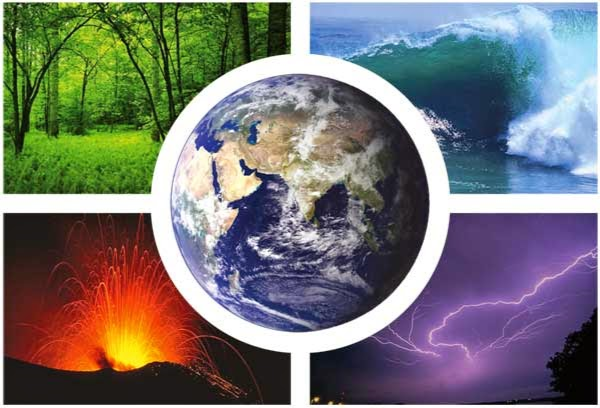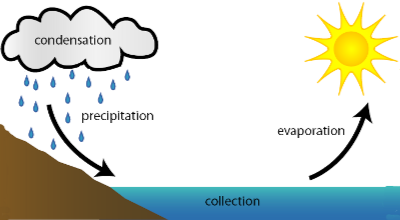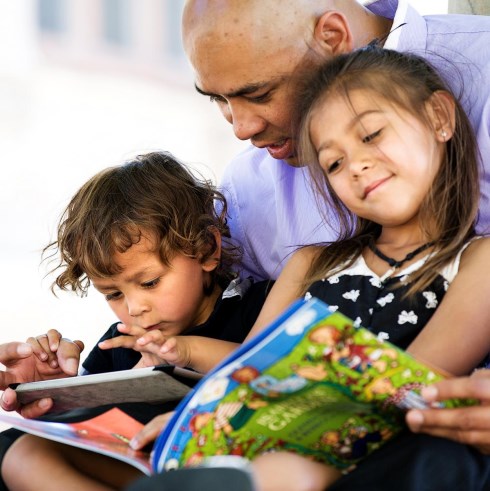Preschool children are born to explore and learn about the world around them (i), and studies have shown that preschool science education is associated with better development of scientific concepts and increased interest in science in later years (i, ii, iii).
Earth Science is one of the three major areas of science (iv) and is the study of planet Earth. It includes the study of rocks, land, weather and oceans. According to the Nevada Pre-K standards (v), earth science includes observing and identifying everyday weather occurrences, observing and identifying different states of water, and identifying and sorting different rocks and soils. Young children can easily learn about earth science by recording the number of sunny days, keeping track of precipitation, collecting special rocks, and talking about the water cycle. Playing at the sand and water table can be a great learning experience with different materials. In this fact sheet, we focus on wind, water, weather, rocks and soil.

Wind
Wind is the result of air moving around in the atmosphere.
Wind is invisible, but children can see the things that are moved by wind. There are many preschool science activities that deal with wind. Wind activities allow young children to find out what a little moving air can do. The activities can go from easy to difficult, depending on the children’s age and level of interest.
Ideas to Try
Wind Walk - On a windy day, take the children outside for a walk. Look for all the things the wind is moving around. Help the children understand that even though the wind is invisible, we can still see the effects of the wind. Read a book about the wind to promote a discussion about the topic, such as The Wind Blew by Pat Hutchins.
Wind Sock - Decorate the top of a paper bowl with small squares of tissue paper and tape streamers around the edge of the bowl. Poke a hole through the top, and insert a pipe cleaner loop. Secure the loop under the bowl. Guide the children to hang the windsock outdoors, and watch the wind blow. Ask questions, such as “Is it windy today?” or “Which direction is the wind blowing?”
Water
Water is everywhere in our lives. We drink it, bathe in it, cook with it and wash our hands several times on a daily basis. Water is a great topic that preschool children could explore. Children can learn about the physical properties of water, the changing states of water, rain and water’s role in nature, the many uses of water, and how water changes.
Ideas to Try
Does it Dissolve? - Set up a dissolve experiment station with several items (i.e., salt, flour, sugar, brown sugar, noodles, cornmeal, oatmeal, sprinkles, etc.). Ask children to predict and observe what will dissolve and disappear in water and what won’t. Create a chart with the children, and help them record what they observe.
Water Cycle Experiment - Talk about the water cycle and what happens when it rains outside. Introduce a book about water cycle, such as The Drop Goes Plop by Sam Godwin and Simone Abel.
Fill up a cup with water and put whipped cream on top to represent white clouds. A separate cup of water needs to be dyed blue to represent the water vapor.
Use a dropper to drop the blue water into the whipped cream cloud. When the cloud can’t hold any more water vapor, precipitation will occur, and the blue water will rain down into the
bottom of the cup.


Weather
Parents or teachers often talk about weather with preschool children, especially when it rains or snows, or is very windy or very sunny outside. Teaching children to observe weather at a young age is valuable. Children can also learn that the weather is different at various locations. In some places, it’s sunny and hot, while in other places it’s snowing and cold.
Ideas to Try
Weather Graph - Create a chart indicating if each day is sunny, rainy, cloudy, snowy, etc. and help children keep track of weather each day.
Tornado Bottle - Simply fill a tall narrow plastic bottle with water, and squirt in a small amount of dish soap (nonconcentrated).
Cover tightly. Give a good shake and watch! You will get a tornado! To help increase children’s understanding of tornadoes, read a related book, such as Otis and the Tornado by Loren Long.
Photo by Jeff Kubina.

Rocks and Soil
Young children love to collect pebbles on the playground and play with the sand in the sand-box. They may not recognize it, but they are already exploring rocks and soil by playing with them. If children are guided to explore rocks, this can help them improve their science knowledge.
Ideas to Try
Rock to Soil - Rub two rocks (limestone and chalky rock) together. Talk about how they make sandy dust. You can also go outside and use a hammer to crack rocks into sand. Make sure to wear safety goggles and take turns. Talk with children about how long it takes nature to make soil or what the sand has in common with the rocks it came from. Read about rocks and soil in related books, such as Rocks and Soil: Real Size Science by Rebecca Rissman to help children’s understanding.
Rock Sound - Have several rocks and a few different containers ready. Try to find containers made of different materials. Place rocks in different containers. Listen to sounds as children shake rocks in each container. Talk about the different sounds everybody hears.
Fun Books to Share
- Miranda Paul & Jason Chin, Water is Water: A Book about the Water Cycle.
- Roma Gans, Let’s Go Rock Collecting.
- Erin Edison, Clouds.
- Peggy Christian, If You Find a Rock.
- Vicki Cobb & Julia Gorton, I Face the Wind.
- Pat Hutchins, The Wind Blew.
- Sam Godwin & Simone Abel, The Drop Goes Plop.
- Loren Long, Otis and the Tornado.
- Rebecca Rissman, Rocks and Soil: Real Size Science.

Conclusion
Young children are natural scientists who always question, hypothesize, explore and investigate (iii). This inherent talent can be the foundation for science with young children. Teachers or parents can help young children find excitement and motivation in science. Exposure to quality science learning experiences during preschool years can improve children’s scientific knowledge.vi Engaging young children in developmentally appropriate hands-on earth science experiences can help them explore and discover the world around them.
References
- Eshach, H., & Fried, M. (2005). Should science be taught in early childhood? Journal of Science, Education and Technology, 14(3), 315-336.
- Guo, Y., Piasta, S. B., & Bowels, R. P. (2015). Exploring preschool children’s science content knowledge. Early Education and Development, 26, 125-146.
- Bosse, S., Jacobs. G., & Anderson, T. L. (2009, November). Science in the Air. Young Children, 10-16.
- Trundle, K. C., & Saçkes, M. (2012). Science and early education. In R. C. Pianta, W. S. Barnett, L. M. Justice, & S. M. Sheridan (Eds.), Handbook of early childhood education (pp. 240-258). New York, NY: Guilford Press.
- Nevada Department of Education (2010). Nevada pre-kindergarten standards.
- French, L. A., & Woodring, S. (2012). Science education in the early years. In B. Spodek & O. Saracho (Eds.), Handbook of research on the education of young children (3rd ed., 179-185). New York, NY: Taylor & Francis.
Kim, Y., Weigel, D., and Byington, T.
2017,
Science in the Preschool Classroom: Earth Science,
University of Nevada Cooperative Extension


